2020: Year-End Thoughts

H.P. Lovecraft’s Color Out Of Space (2019)
Well, it’s that time of year again, when someone like me who writes a lot about movies feels obligated to offer some kind of summation of what I watched over the past twelve months. As in most recent years, this has little to do with new movies released in the current year – between my protracted recovery from shoulder surgery and then the onset of the pandemic just as my life was starting to return to normal, I saw only one new release in a theatre – Robert Eggers’ The Lighthouse – though that was such an intense and concentrated experience it could count for ten regular movies.
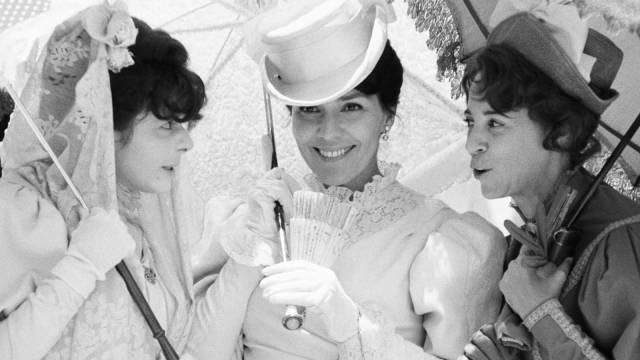
At home, on disk and occasionally on-line, I saw around six-hundred movies, many of which hail from years and even decades in the past. Some of these were new disk releases of older movies, some older disks only now falling into my hands. So once again, what I mention here has little to do with 2020 itself; it’s just about my personal experience in that arbitrary chunk of time. Another caveat is that there’s a natural tendency to perhaps overvalue what I have seen more recently as memory of things seen eight, nine, twelve months ago has faded somewhat – if I didn’t keep a record of what I watch (or have this blog to look back on), I might well have neglected to mention things which should definitely be included in my summary.
And finally, all of this is by its nature completely subjective – what follows does not necessarily represent the best movies I saw or the best disk editions released; rather, these are titles which engaged me for many different reasons and stick in my memory as particularly satisfying and worthwhile experiences.
*
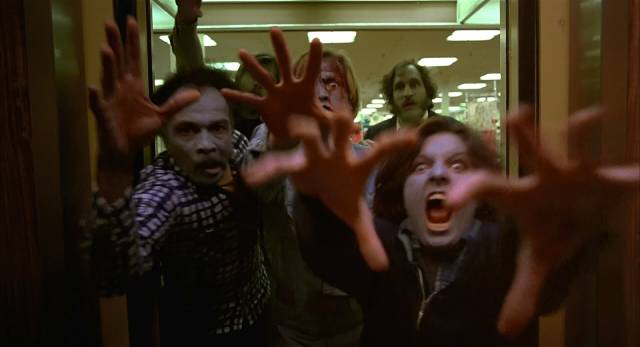
Box sets
Was 2020 a particularly good year for box sets? It certainly seemed so, with various companies lavishing time and resources on a wide range movies, once again (I know I say this every year) giving the lie to those who still like to proclaim the imminent death of physical media. Herewith, a lucky thirteen, mostly actually released this year:
Dawn of the Dead (George A. Romero, 1978): Hands down, for me the release of the year was Second Sight’s massive tribute to George A. Romero’s epic Dawn of the Dead, four Blu-rays with one disk dedicated to each of the three variant cuts and a fourth containing seven hours of new and archival material, plus three CDs of soundtrack music (the Goblin score and numerous library tracks) and two books. Immersing myself in this bonanza pushed me to finally watch the three early features in Arrow’s George A. Romero: Between Night and Dawn set: There’s Always Vanilla (1971), Jack’s Wife (aka Season of the Witch, 1972) and The Crazies (1973) show a talented filmmaker working out his cinematic voice and thematic interests. (Second Sight also released a 4K Ultra HD set, but I’m still not ready to take that step!)

The Beastmaster (Don Coscarelli, 1982): Just in time for Christmas, Vinegar Syndrome has released a 4K restoration of the best Sword and Sorcery movie ever made – Don Coscarelli’s The Beastmaster (it comes in a dual-format 4K UHD/Blu-ray three-disk set). I was lucky enough to see this cult favourite during its original brief theatrical run. It looks even better now, with every detail and nuance of John Alcott’s colourful, atmospheric cinematography beautifully rendered. This is epic filmmaking which never betrays its limited budget (under $5-million!). The battles are spectacular, the animal performances incredibly expressive, and Rip Torn, wax nose and all, is a terrific villain. Marc Singer and Tanya Roberts were ready-made for the Frank Frazetta-like visuals and there has never been anything like the movie’s fantasy high point, creepy bat-like creatures that envelope people in their cape-like wings and dissolve their flesh in an instant. I love this movie.

I have a vivid memory of chatting with Rafaella De Laurentiis in the summer of 1983 when she was producing Dune and preparing the Conan sequel. She hadn’t settled on a director yet (it eventually fell to Richard Fleischer) and I said what about Don Coscarelli? She looked at me as if I was mad and asked incredulously if I meant the guy who’d made Beastmaster. At that moment I knew without question that she had absolutely no understanding of fantasy – Coscarelli’s movie is vastly superior to the De Laurentiis-John Milius Conan which lumbers across the screen with ponderous self-seriousness despite five times the budget.
All of which explains why I was surprised and a little depressed by Elijah Drenner’s feature-length making-of on the Beastmaster disk from which I learned that the production was a very unhappy experience for Coscarelli who had to fight interference from the producer throughout the shoot and was finally dismissed from the editing room, losing control of the cut, which doesn’t now represent his original intentions. How can something this good and entertaining be a disappointment to its creator? I love Coscarelli’s work, so should I now be ambivalent about The Beastmaster despite having been an unalloyed fan for four decades? It’s all very confusing!

Three Fantastic Journeys by Karel Zeman (1955/58/62): What more can be said than that Criterion provided a beautiful showcase for three fantasies by the Czech master of live action blended with storybook-like animation? Zeman was a true heir of Georges Melies, a playful and sophisticated purveyor of visual wonders.
The Complete Lenzi/Baker Giallo Collection (1969/70/72): Pairing up with a Hollywood star dissatisfied with her career, Italian director Umberto Lenzi made a series of four features in the late-’60s, early ’70s which show the transition from classical mysteries to the twisted psychological and sexual extremes of the giallo. Carroll Baker, notorious for her breakthrough performance in Elia Kazan’s Baby Doll (1956), relishes roles which would have been unacceptable back in Hollywood for an actor of her stature. Severin packaged all four of the films in an impressive set with interviews, commentaries, variant cuts and soundtrack CDs.

Gamera: The Complete Collection (Various, 1965-2006): Arrow’s very deluxe edition of all twelve films (plus variant cuts) starring the rocket-powered turtle Gamera is the Platonic ideal of the box set, with exemplary transfers, commentaries, hours of documentaries, a hardcover book of the colour comics published in the ‘90s to coincide with Gamera’s revival, a softcover book of essays, and even a map of Japan pinpointing all the locations where the turtle and his enemies rampaged through four decades.
World Cinema Project 3 (Various, 1934-80): Criterion’s third anthology of features saved and restored by the Film Foundation’s on-going World Cinema Project gathers another six movies from multiple countries across six decades, revealing a range of styles and influences and political passions: Juan Bustillo Oro’s Dos Monjes (Mexico, 1934), Usmar Ismail’s After the Curfew (Indonesia, 1954), Humberto Solas’ Lucia (Cuba, 1968), Med Hondo’s Soleil Ô (Mauritania, 1070), Bahram Beyzaie’s Downpour (Iran, 1972) and Hector Babenco’s Pixote (Brazil, 1980).

Forgotten Gialli 1 & 2 (Various, 1972-78): The giallo, like film noir, is fairly amorphous, as much in the eye of the beholder as it is a clearly defined category. An Italian genre which developed from the mid-to-late-’60s and gradually petered out by the mid-’80s, its international popularity saw it spread to other countries where exploitation filmmakers embraced its lurid mix of twisted psychology, perverse sexuality and graphic violence. Although the giallo has achieved widespread popularity on home video, there are still numerous obscure byways to be explored – quite a few of the hundred-plus titles included in Severin’s huge trailer compilation All the Colors of Giallo have yet to be released – and Vinegar Syndrome has begun to dip into the often foetid pool with a couple of three-disk sets tagged Forgotten Gialli. I might argue that most of the films included aren’t pure gialli, and they range from rather crude (a couple produced by American exploitation specialist Dick Randall) to highly polished (Tonino Valerii’s My Dear Killer). Volume one features three Spanish rather than Italian movies, one a talky country-house mystery (with a high body count), another with echoes of Psycho; in the second set, the Randall-produced Girl in Room 2A is more updated Gothic than giallo, while the Paris-set French Sex Murders is a tonally awkward slasher in which the most enjoyable element is Howard Vernon as a deranged scientist, while the investigating cop is jarringly played by Robert Sacchi, who based his career on a vague resemblance to Humphrey Bogart which is distractingly exploited here through vocal intonation and costume (trenchcoat and fedora). Valerii’s film is definitely the high point, but the sets do illustrate how the giallo spread out from Italy, at least for a few years before it was largely supplanted by the American slasher.
Maigret: The Complete Series (Various, 1991-2004): This massive, thirty-disk set containing all fifty-four feature-length episodes of the French television series starring Bruno Cremer as the famous detective gave me a really enjoyable month of binge viewing during the lockdown earlier this year. Made over fourteen years (1991-2004), the quality remains impressively consistent. Hooked, I’ve been reading Georges Simenon’s novels in a series of reading binges since I watched the movies.
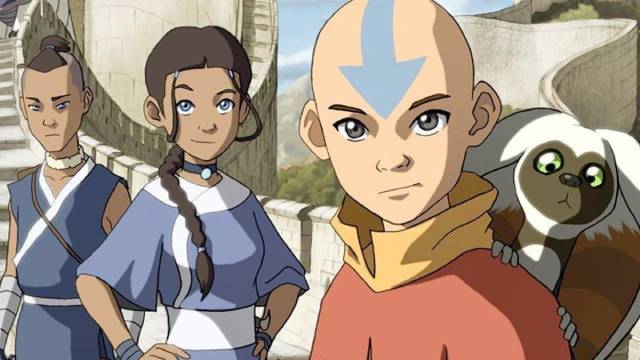
Avatar The Last Airbender (2005-08)/Legend of Korra (2012-14): As always in the minority regarding M. Night Shyamalan, I enjoyed his live-action feature version of The Last Airbender (2010). I had never seen the animated TV series and assumed it was typical throwaway kids’ stuff. But more recently, I came across some serious commentary and took a chance on ordering the series on Blu-ray. It turned out to be terrific, a richly imagined fantasy world which was created by people with an obvious respect and admiration for the best of anime – informed by Hayao Miyazaki’s work without being slavishly imitative. For a Nickelodeon series, it has surprising depth, with well-developed characters, thematic and narrative complexity, and a level of visual detail worthy of feature animation. Having immersed myself in the original series, I immediately bought the follow-up Legend of Korra, which is equally well-produced, though the loss of the original characters left me a bit disappointed.
The Larry Fessenden Collection (1991-2006): Although this four-disk set was released in 2015, I only picked it up this year and I was glad I did – revisiting Larry Fessenden’s first four features reminded me of just how significant he is as a filmmaker working on the fringes of the mainstream, investing familiar horror tropes with intelligence and a fresh perspective. Far from prolific (only six features in almost thirty years), he has had a larger influence through his work as a producer and actor, nurturing other genre filmmakers – but these four films are absolute gems.
*

in Sion Sono’s The Whispering Star (2015)
Single disks
Individual titles which stand out for me this year range all over the place – new, old, documentary, serious drama and exploitation …
The Whispering Star (Sion Sono, 2015): Sion Sono’s haunting, hand-crafted fantasy about the scattered remnants of humanity maintaining fragile contact via couriers who spend years isolated in space as they deliver trivial packages from one planet to another, mixes melancholy and hope and makes expressive use of the abandoned region around Fukushima to evoke the terminal state of our species.
Aniara (Pella Kågerman and Hugo Lilja, 2018): Another science fiction movie which defies many of the commercial conventions of the genre, Aniara by first-time feature directors Pella Kågerman and Hugo Lilja is an epic meditation on our species’ place in the universe which eventually stretches over millennia as a disabled spaceship drifts in an emptiness its crew and passengers can barely comprehend.

in Ashley Thorpe’s Borley Rectory (2017)
Borley Rectory (Ashley Thorpe, 2017): Ashley Thorpe’s meditation on “the most haunted house in England” is literally hand-crafted, every frame built layer by layer by Thorpe who shot performers against green-screen to reenact moments from the Rectory’s history and then digitally painted all the environments based on old photographs. The film bridges the gap between 19th Century photography and up-to-date digital imaging to create an effectively ghostly atmosphere evocative of silent film and spirit photography. A unique piece of visual art.
Daniel Isn’t Real (Adam Egypt Mortimer, 2019): Adam Egypt Mortimer’s second feature transforms childhood trauma into adult horror as his protagonist’s psychological problems manifest in an increasingly unstable world in which demonic forces impinge dangerously on everyday life.

First Love/Over Your Dead Body (Takashi Miike, 2019/2014): Two very different movies from the incredibly prolific Takashi Miike, one from last year, the other released in 2014; First Love is a mixture of pulp romance and violent action, Over Your Dead Body an evocative blend of cinematic experiment and classical Japanese theatre … and both are among his best work of recent years.
Motherless Brooklyn (Edward Norton, 2019): Edward Norton’s adaptation of Jonathan Lethem’s novel is quite simply the best American detective movie since Chinatown.

Depraved (Larry Fessenden, 2019): Larry Fessenden’s first feature in six years is a superb new version of something about which by now you’d think there was nothing fresh to say. This updated adaptation of Frankenstein continues Fessenden’s exploration of the ethical issues inherent in capitalist-based scientific research and centres on one of the finest Creatures yet put on screen.
Color Out of Space (Richard Stanley, 2019): The idiosyncratic Richard Stanley returns after an even longer hiatus with his first dramatic feature in twenty-seven years – a visually striking, moody adaptation of H.P. Lovecraft’s much-filmed novella. Stanley has lost none of his mastery of enigmatic horror – inspired by this, I revisited both Hardware and Dust Devil and was left wondering why this talented filmmaker had to wait so long for producers to give him another opportunity.

The Whisperers (Bryan Forbes, 1967): I’d somehow missed this Bryan Forbes movie from 1967 until its recent Blu-ray release from Kino Lorber, and the sense of discovery just added to the pleasure of watching one of Forbes’ finest films. A potent mix of social realism and psychological horror, it’s centred on Dame Edith Evans’ remarkable performance as an elderly woman living alone and sliding inexorably into paranoid fantasies as her mind tries desperately to retreat from her dependence on a collapsing welfare state.
Black Rainbow (Mike Hodges, 1989): I’d also missed this supernaturally-tinged thriller set in the dying towns of the American rust belt. It follows an itinerant religious huckster and the daughter he’s exploited since childhood whose church revival visions begin to predict imminent deaths among an audience craving reassurance. One of Mike Hodges’ best films.

in Sergio Martino’s American Rickshaw (1989)
American Rickshaw (Sergio Martino, 1989): A master of gialli and poliziotteschi, Sergio Martino was one of a number of Italian genre filmmakers who travelled to the U.S. in the ’80s as their native industry began to shrink. This is one of the most entertaining films to come out of that period, a mash-up of martial arts, magic, and hanging out on the beaches of Florida. A great debut release from Cauldron Films.
Town Bloody Hall (D.A. Pennebaker & Chris Hegedus, 1979): D.A. Pennebaker and Chris Hegedus’ documentary captures a particular moment during a period of social upheaval. The Vietnam War was still raging, resistance was increasing, Nixon was sinking into the end stages of his criminal paranoia … and women were openly and loudly demanding equal rights. One evening in New York several prominent feminists joined a panel chaired by the vociferous spokesman of dominant masculinity Norman Mailer, and for a couple of hours an audience of New York’s middle class intellectual elite witnessed a debate loaded with anger and acid humour.
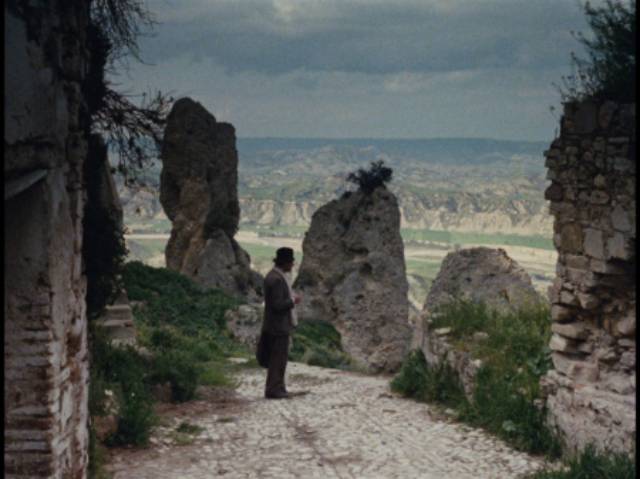
in Francesco Rosi’s Christ Stopped at Eboli (1979)
Christ Stopped at Eboli/Three Brothers (Francesco Rosi, 1979/1981): Francesco Rosi emerged from a period of turbulent political violence at the end of the ’70s with two meditative studies of the impact of that turbulence on Italian society, the first set in the Fascist past, the second in contemporary Italy. Both portray a nation sharply divided between North and South, between urban and rural, between past and present … and both are rich in tone and character, illuminating the effects of political and economic conflict on specific individuals.
Jesus Shows You the Way to the Highway/Crumbs (Miguel Llansó, 2019/2015): A pair of films by the previously unknown (to me) Miguel Llansó, apocalyptic mash-ups of pop culture pulp and politics, funny and haunting and endlessly inventive.
*
All of these were new to me; but there were also rewarding new editions of films previously seen, in some cases decades ago …

Secret Ceremony/Boom! (Joseph Losey, 1968): In the ’60s, the usually very serious Joseph Losey threw himself into several projects which were the epitome of melodramatic camp, and two of them are among his finest and most enjoyable movies. Probably not coincidentally, both starred Elizabeth Taylor – in Boom! paired with husband Richard Burton, in Secret Ceremony with Mia Farrow and Robert Mitchum – and capitalized on her celebrity, no longer merely an actress but rather some oversized caricature of embodied fame. Both films look wonderful on Blu-rays from, respectively, Indicator and Kino Lorber.
Junior Bonner (Sam Peckinpah, 1972): Sam Peckinpah followed his greatest and most disturbing film, Straw Dogs, with one of his gentlest, Junior Bonner. Set on the rodeo circuit in the Southwest, it’s a meditation on aging, the fragility of family, and the disappearance of a way of life, and it gave Steve McQueen one of his best roles.
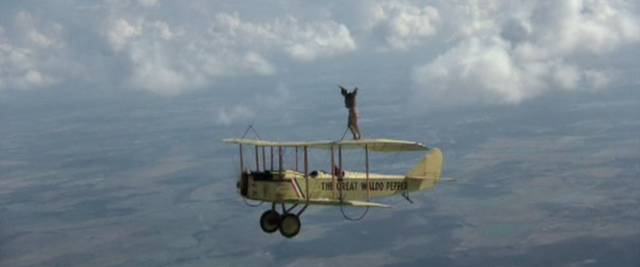
in George Roy Hill’s The Great Waldo Pepper (1975)
The Great Waldo Pepper (George Roy Hill, 1975): Following the commercial success of Butch Cassidy and the Sundance Kid, Slaughterhouse-Five and The Sting, director George Roy Hill teamed again with writer William Goldman for his most personal project, rooted in his own early experiences as a pilot. But this story of World War One flyers struggling to survive as barnstorming entertainers in the 1920s tanked at the box office. Hill and Goldman attributed its failure to an abrupt, shocking shift in tone halfway through, but when I saw the film back in 1975 that very moment is what made me embrace it, a lighthearted adventure suddenly becoming a devastating meditation on mortality and a desire to stave off inevitable oblivion. The spectacular pre-CG flying sequences seem even more breathtaking today on Shout Select’s handsome (but sadly extras-free) Blu-ray.
Come Drink With Me/The Fate of Lee Khan/Raining in the Mountain (King Hu, 1966/1973/1979): With two more releases from Masters of Cinema and a third from 88Films, almost all of King Hu’s major works are now available in all their spectacular beauty on Blu-ray. With his first significant film, Come Drink With Me, Hu transformed the traditional Hong Kong martial arts movie; The Fate of Lee Khan plays with conventions he himself had helped to create; and Raining in the Mountain moves beyond those conventions with a mixture of martial arts action and a meditation on politics and spirituality in a large monastery.

Come and See (Elem Klimov, 1965): Criterion gave Elem Klimov’s hallucinatory film an impressive restoration on Blu-ray; one of the most unsettling war movies ever made, it observes the extremes of human violence through the eyes of a boy too young to have yet formed a stable relationship with the world. A nightmare that promises no escape from the horror.
The Appaloosa/The Ipcress File (Sidney Furie, 1966/1965): Sometimes revisiting movies after a gap of years – or decades – yields an experience which diverges sharply from memory. I’d only seen Sidney Furie’s The Appaloosa once before, on television some fifty years ago, and recalled being nothing but irritated by the visual style. But that was pan-and-scanned on a black-and-white TV; in all its widescreen and colour glory, I loved it on Kino’s Blu-ray – it’s up there with Marlon Brando’s One-Eyed Jacks as a meditation on the themes and form of the Western. Furie’s The Ipcress File, on the other hand, has been one of my favourite spy movies from the golden age of the ’60s – and yet, watching it again after many years, I found the visual style … well, kind of irritating. So, a reversal of opinion on both films. It’s interesting to hear (in the disk extras) that Furie thought the script, adapted from the Len Deighton novel, was rubbish and his style (extreme camera angles, distorting lenses) was his way of trying to make something of material he didn’t like.

in Claire Denis’ Beau Travail (1999)
Beau Travail (Claire Denis, 1999): Claire Denis’ almost wordless meditation on masculinity and work is more sumptuously beautiful than ever in Criterion’s 4K restoration. Although drawn from a literary source (Herman Melville’s Billy Budd), this could only exist as a film – image and sound, vast landscapes and human faces, blending into an exquisite and mysterious vision that lingers hauntingly in memory.
Comments